Schwalm-Eder-Kreis is a Kreis (district) in the north of Hesse, Germany. Neighbouring districts are Kassel, Werra-Meißner, Hersfeld-Rotenburg, Vogelsberg, Marburg-Biedenkopf, and Waldeck-Frankenberg.

Rauschenberg is a town in the north of Marburg-Biedenkopf district in Hesse, Germany.

Schwalm-Eder is an electoral constituency represented in the Bundestag. It elects one member via first-past-the-post voting. Under the current constituency numbering system, it is designated as constituency 170. It is located in northern Hesse, comprising the Schwalm-Eder-Kreis district and the southern part of the Waldeck-Frankenberg district.

Borken is a small town with about 13,000 inhabitants in the Schwalm-Eder district in northern Hesse, Germany.
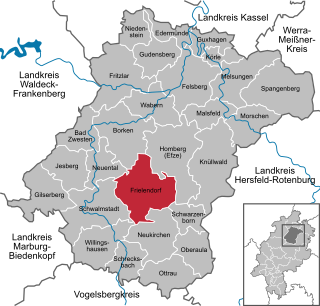
Frielendorf is a municipality in the Schwalm-Eder district, Hesse, Germany.

Melsungen is a small climatic spa town in the Schwalm-Eder district in northern Hesse, Germany. In 1987, the town hosted the 27th Hessentag state festival.

Neuental is a municipality in the Schwalm-Eder district in Hesse, Germany.

Oberaula is a municipality in the Schwalm-Eder district in Hesse, Germany.

Schrecksbach is a municipality in the Schwalm-Eder district in Hesse, Germany.
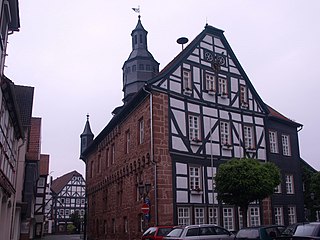
Treysa, an independent town until 1970, is the biggest Stadtteil of the German town Schwalmstadt. It was incorporated into Schwalmstadt in December 1970. The location around Treysa and Schwalmstadt is called Schwalm. The historic city lies on a hill which is up to 35 meters higher than the valley where the river Wiera enters in the Schwalm. To protect the city of floods, a detention basin had been built.

Schwarzenborn is the smallest town in Hesse, Germany. It lies in the Schwalm-Eder district some 13.5 km from Homberg in the Knüll. Through the constituent community of Grebenhagen flows the river Efze. The town consists of the two centres of Grebenhagen and Schwarzenborn.
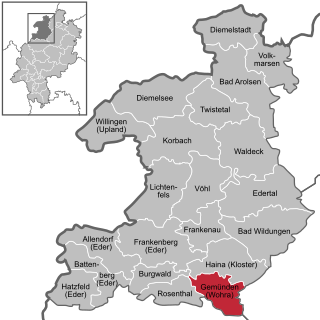
Gemünden is a town in Waldeck-Frankenberg district in Hesse, Germany.
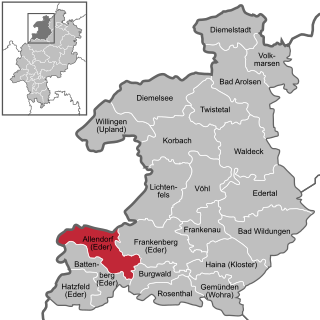
Allendorf (Eder) (German: [ˈaləndɔʁf](listen)) is a municipality which situated in the north west of Hesse, Germany. The municipality is within the Waldeck-Frankenberg district in a rural region called the upper Eder Valley. The Burgwald range is located west of Allendorf while the Breite Struth hills are in Allendorf's east.

1. FC Schwalmstadt is a German association football club from the city of Schwalmstadt, Hesse which was established in 1970 through the amalgamation of the towns of Treysa and Ziegenhain together with some smaller outlying villages.
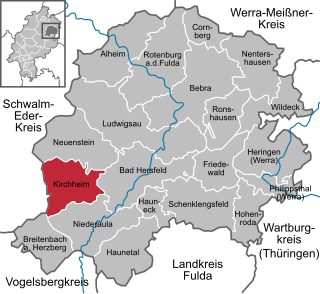
Kirchheim is a municipality in Hersfeld-Rotenburg district in northeastern Hesse, Germany.

The Main–Weser Railway is a railway line in central Germany that runs from Frankfurt am Main via Gießen to Kassel. it is named after the railway company that built the line and also operated it until 1880. It was opened between 1849 and 1852 and was one of the first railways in Germany.

The West Hesse Depression is part of the West Hesse Highlands and Lowlands region in the north of the German state of Hesse. Like the East Hesse Depression, it is a series of separate depressions that form a natural corridor and have been an important historical trade route.

Treysa station is a train station in Schwalmstadt, Hesse, on the Main–Weser Railway. It was formerly a railway junction, connecting to the Leinefelde–Treysa section of the Cannons Railway.

The Treysa Meteorite, also known as the Rommershausen Meteorite, is an astronomical relic found in a wooded area near the Rommershausen district of Schwalmstadt in northern Hesse, Germany. The meteorite made German astronomical history as one of the most significant confirmed meteorite collisions of recent history. It is classified as a medium octahedrite of the IIIB chemical class and shows Widmanstätten patterns.

Carl Ludwig Noah Bantzer was a painter, professor and art critic; associated with the Willingshausen Artists' Colony.
























